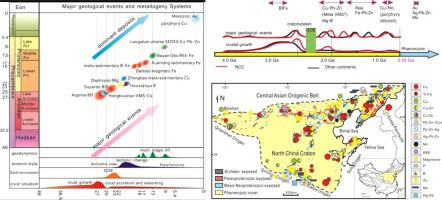当前位置:
X-MOL 学术
›
J. Asian Earth Sci.
›
论文详情
Our official English website, www.x-mol.net, welcomes your feedback! (Note: you will need to create a separate account there.)
Continental crustal evolution and synchronous metallogeny through time in the North China Craton
Journal of Asian Earth Sciences ( IF 3 ) Pub Date : 2020-06-01 , DOI: 10.1016/j.jseaes.2019.104169 Mingguo Zhai , Xiyan Zhu , Yanyan Zhou , Lei Zhao , Ligang Zhou
Journal of Asian Earth Sciences ( IF 3 ) Pub Date : 2020-06-01 , DOI: 10.1016/j.jseaes.2019.104169 Mingguo Zhai , Xiyan Zhu , Yanyan Zhou , Lei Zhao , Ligang Zhou

|
Abstract The generation and evolution of continent crust have long been matters of debates. There is evidence to support the view that the first formation of TTGs of continent was possibly before 4.4 Ga, followed by the sizable continent crust associated with BIF-bearing supra-crustal rocks at ca. 3.8 Ga. Multiple stages of continental growth include continental nuclei at ~3.1 Ga, enormous crustal growth at 2.9–2.7 Ga and stabilization and cratonization at ~2.5 Ga. Subsequently a stable super-continent was formed and the Earth was evolved into the Proterozoic eon. In the Proterozoic eon, major geological events include the great oxygen event (GOE), global rift and mobile belt event, and the Earth’s middle age event with a 1.0 billion years long period of Earth’s adjustment or silence. After that, the Rodinian super-continental break up event (the Nanhua rift) and subsequent Gondwana amalgamation have been suggested to be involved with mantle-plume and the modern style-like plate tectonics, both of which are still under debates. Recent studies suggest that the continental metallogeny has secular changes with the evolving Earth, showing synchronous evolution with the continental crust through time. The North China Craton (NCC) is one of the oldest cratons in the world, and has undergone six major tectono-metallogenic cycles: (1) the Neoarchean crustal growth and Algoman-type BIFs-greenstone belt and gold metallogenic system, (2) Paleoproterozoic GOE associated with global (Huronian) rifting- Glaciation and Superior-type BIFs-Mg-B metallogenic system, (3) Paleoproterozoic rifting-subduction-accretion-collision event (mobile belt) and Cu-Pb-Zn metallogenic system; (4) Late Paleoproterozoic – Neoproterozoic multi-stage rifting and REE-Fe-Pb-Zn metallogenic system; (5) Paleozoic orogenesis at the margins of the craton and porphyry Cu-Mo metallogenic system; and (6) Mesozoic extensional tectonics associated with lithosphere thinning and intracontinental Au metallogenic systems. Ore deposit types in each of these metallogenic systems show distinct characteristics and tectonic affinities. Changes of metallogenic styles with time, from the dominant BIFs in Archean to polymetallic deposits in Proterozoic and Phanerozoic, demonstrate that the nature and style of metallogeny through time change with different stages of the Earth’s evolution and are the expression of variable materials at the different stages. The changes of metallogeny through time are controlled by the irreversible continental tectonic evolution. The connotation and signification of synchronous evolution of continental crust and mineral deposit systems through time are beyond the study of mineral resources but would provide new insights into the geodynamics of the generation and evolution of the continent. The NCC provides an excellent venue to address the linkage between metallogenic processes and secular changes in the Earth System, including mantle dynamics and crust-mantle interaction on a global perspective.
中文翻译:

华北克拉通大陆地壳演化与同步成矿
摘要 大陆地壳的产生和演化长期以来一直是争论的焦点。有证据支持这样的观点,即大陆 TTGs 的第一次形成可能是在 4.4 Ga 之前,随后是与含 BIF 的上地壳岩石相关的相当大的大陆地壳。3.8 Ga。大陆生长的多个阶段包括~3.1 Ga的大陆核、2.9-2.7 Ga的巨大地壳生长和~2.5 Ga的稳定和克拉通化。随后形成稳定的超级大陆,地球演化为元古代. 在元古代,主要的地质事件包括大氧事件(GOE)、全球裂谷和移动带事件,以及地球调整或沉默周期长达10亿年的地球中年事件。之后,罗迪尼亚超大陆分裂事件(南华裂谷)和随后的冈瓦纳合并已被认为与地幔柱和现代风格的板块构造有关,两者仍在争论中。最近的研究表明,大陆成矿随着地球的演化而发生长期变化,随着时间的推移与大陆地壳呈同步演化。华北克拉通(NCC)是世界上最古老的克拉通之一,经历了六个主要的构造成矿旋回:(1)新太古代地壳生长和阿尔戈曼型BIFs-绿岩带和金成矿系统,(2)与全球(休伦期)裂谷作用相关的古元古代GOE-冰川和Superior-type BIFs-Mg-B成矿系统,(3) 古元古代裂谷-俯冲-增生-碰撞事件(移动带)与Cu-Pb-Zn成矿系统;(4)晚古元古代—新元古代多期裂谷与REE-Fe-Pb-Zn成矿系统;(5) 克拉通边缘古生代造山作用和斑岩铜钼成矿系统;(6) 与岩石圈减薄和陆内金成矿系统相关的中生代伸展构造。每个成矿系统中的矿床类型都显示出不同的特征和构造亲和力。成矿样式随时间的变化,从太古宙占主导地位的BIFs到元古界和显生界的多金属矿床,证明成矿的性质和风格随着地球演化的不同阶段随时间而变化,是不同阶段可变材料的表现。成矿随时间的变化受不可逆转的大陆构造演化控制。大陆地壳和矿床系统随时间同步演化的内涵和意义超出了矿产资源的研究,但将为大陆生成演化的地球动力学提供新的见解。NCC 提供了一个很好的场所来解决地球系统中成矿过程与长期变化之间的联系,包括从全球角度看地幔动力学和壳幔相互作用。成矿随时间的变化受不可逆转的大陆构造演化控制。大陆地壳和矿床系统随时间同步演化的内涵和意义超出了矿产资源的研究,但将为大陆生成演化的地球动力学提供新的见解。NCC 提供了一个很好的场所来解决地球系统中成矿过程与长期变化之间的联系,包括从全球角度看地幔动力学和壳幔相互作用。成矿随时间的变化受不可逆转的大陆构造演化控制。大陆地壳和矿床系统随时间同步演化的内涵和意义超出了矿产资源的研究,但将为大陆生成演化的地球动力学提供新的见解。NCC 提供了一个很好的场所来解决地球系统中成矿过程与长期变化之间的联系,包括从全球角度看地幔动力学和壳幔相互作用。大陆地壳和矿床系统随时间同步演化的内涵和意义超出了矿产资源的研究,但将为大陆生成演化的地球动力学提供新的见解。NCC 提供了一个很好的场所来解决地球系统中成矿过程与长期变化之间的联系,包括从全球角度看地幔动力学和壳幔相互作用。大陆地壳和矿床系统随时间同步演化的内涵和意义超出了矿产资源的研究,但将为大陆生成演化的地球动力学提供新的见解。NCC 提供了一个很好的场所来解决地球系统中成矿过程与长期变化之间的联系,包括从全球角度看地幔动力学和壳幔相互作用。
更新日期:2020-06-01
中文翻译:

华北克拉通大陆地壳演化与同步成矿
摘要 大陆地壳的产生和演化长期以来一直是争论的焦点。有证据支持这样的观点,即大陆 TTGs 的第一次形成可能是在 4.4 Ga 之前,随后是与含 BIF 的上地壳岩石相关的相当大的大陆地壳。3.8 Ga。大陆生长的多个阶段包括~3.1 Ga的大陆核、2.9-2.7 Ga的巨大地壳生长和~2.5 Ga的稳定和克拉通化。随后形成稳定的超级大陆,地球演化为元古代. 在元古代,主要的地质事件包括大氧事件(GOE)、全球裂谷和移动带事件,以及地球调整或沉默周期长达10亿年的地球中年事件。之后,罗迪尼亚超大陆分裂事件(南华裂谷)和随后的冈瓦纳合并已被认为与地幔柱和现代风格的板块构造有关,两者仍在争论中。最近的研究表明,大陆成矿随着地球的演化而发生长期变化,随着时间的推移与大陆地壳呈同步演化。华北克拉通(NCC)是世界上最古老的克拉通之一,经历了六个主要的构造成矿旋回:(1)新太古代地壳生长和阿尔戈曼型BIFs-绿岩带和金成矿系统,(2)与全球(休伦期)裂谷作用相关的古元古代GOE-冰川和Superior-type BIFs-Mg-B成矿系统,(3) 古元古代裂谷-俯冲-增生-碰撞事件(移动带)与Cu-Pb-Zn成矿系统;(4)晚古元古代—新元古代多期裂谷与REE-Fe-Pb-Zn成矿系统;(5) 克拉通边缘古生代造山作用和斑岩铜钼成矿系统;(6) 与岩石圈减薄和陆内金成矿系统相关的中生代伸展构造。每个成矿系统中的矿床类型都显示出不同的特征和构造亲和力。成矿样式随时间的变化,从太古宙占主导地位的BIFs到元古界和显生界的多金属矿床,证明成矿的性质和风格随着地球演化的不同阶段随时间而变化,是不同阶段可变材料的表现。成矿随时间的变化受不可逆转的大陆构造演化控制。大陆地壳和矿床系统随时间同步演化的内涵和意义超出了矿产资源的研究,但将为大陆生成演化的地球动力学提供新的见解。NCC 提供了一个很好的场所来解决地球系统中成矿过程与长期变化之间的联系,包括从全球角度看地幔动力学和壳幔相互作用。成矿随时间的变化受不可逆转的大陆构造演化控制。大陆地壳和矿床系统随时间同步演化的内涵和意义超出了矿产资源的研究,但将为大陆生成演化的地球动力学提供新的见解。NCC 提供了一个很好的场所来解决地球系统中成矿过程与长期变化之间的联系,包括从全球角度看地幔动力学和壳幔相互作用。成矿随时间的变化受不可逆转的大陆构造演化控制。大陆地壳和矿床系统随时间同步演化的内涵和意义超出了矿产资源的研究,但将为大陆生成演化的地球动力学提供新的见解。NCC 提供了一个很好的场所来解决地球系统中成矿过程与长期变化之间的联系,包括从全球角度看地幔动力学和壳幔相互作用。大陆地壳和矿床系统随时间同步演化的内涵和意义超出了矿产资源的研究,但将为大陆生成演化的地球动力学提供新的见解。NCC 提供了一个很好的场所来解决地球系统中成矿过程与长期变化之间的联系,包括从全球角度看地幔动力学和壳幔相互作用。大陆地壳和矿床系统随时间同步演化的内涵和意义超出了矿产资源的研究,但将为大陆生成演化的地球动力学提供新的见解。NCC 提供了一个很好的场所来解决地球系统中成矿过程与长期变化之间的联系,包括从全球角度看地幔动力学和壳幔相互作用。


























 京公网安备 11010802027423号
京公网安备 11010802027423号